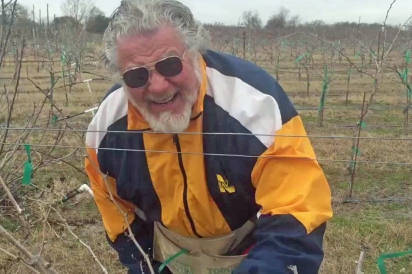Messina Hof Winery: Love Affair with an Old Italian Grape Claimed by Texas
“It’s been an exciting adventure with Sagrantino since we started growing it”, said Paul Bonarrigo, who with his wife Merrill are co-founders of Messina Hof Winery and Resort in Bryan. “You know, with my Italian roots, I just love deep, dark red wines and this one really captivated me.” Paul’s ‘love affair’ with Sagrantino started when the Bonarrigos were teaching wine hospitality and retailing at a wine conference. Paul said, “It was an incredible meeting with people coming from around the world and we all met-up in Umbria.”
Paul and Merrill toured the region and had an opportunity to meet two of the foremost families growing and making Sagrantino wines – the Caprai and Longarotti families. The Bonarrigos toured their vineyards and wineries near the village of Montefalco. Nearly all of Sagrantino comes from Umbria and these families have dedicated themselves to advancing this rustic grape with likely ancient origins from traveling Catholic monks around 1200 AD.
Paul said, “I had a chance to learn about Sagrantino from these masters with details specific to Sagrantino di Montefalco DOCG, a small Umbrian appellation that requires that the wines be 100% Sagrantino. I was originally told that Sagrantino vines were not shipped out of Umbria, as it was a protected grape in Italy. When I returned to the U.S., I contacted University of California at Davis and asked them if I could get Sagrantino vine cuttings. They told me that they had some vines that on import were marked Primitivo, but prior to release they did DNA testing and the vines turned out to the Sagrantino.”
Once they told Paul where to get it, he bought up every Sagrantino plant he could find – 12,000 in all!” After dispersing his Sagrantino cuttings to his High Plains growers, Paul bought more Sagrantino to grow in Bryan. There, it grew so prolifically that he is now converting the trellis system to better support them.
When I asked Paul why did he do it, he said, “You know, when you fall in love, you fall in love.” I guess, it was just a case of love at first taste.
I recently sampled two different Messina Hof bottlings from the 2015 vintage:
Messina Hof Paulo 2015 Sagrantino – a blend with 20% Merlot, recently claimed the only Gold Medal for a Sagrantino wine in an international wine competition in Vienna. This approachable wine has a pleasingly mouth feel with expression of ripe dark plums and black cherries. It is punctuated with a well-founded tannic structure inherent to Sagrantino like that also found in Cabernet Sauvignon and assisted by 14-month aging in hybrid French/American oak barrels. These grapes combined produce a style very much like blends of Cabernet and Merlot in Bordeaux-style wines.
Messina Hof 2015 Sagrantino Reserva – made from 97% Sagrantino with an addition of 3% Petite Verdot using the same barrel treatment. This wine has more of the classic tannic edge as found in Sagrantino di Montefalco and also characteristic of many of the Spanish wines made from oak-aged Tempranillo. Softer than Sagrantino di Montefalco, it is geared more for American palates while yielding concentrated red fruit with a spicy, peppery finish.
Want to try Messina Hof’s Sagrantino offerings? Both wines are available from limited production in the winery’s tasting room in Bryan with the Paulo already available from their online store – check www.messinahof/com. Pair it with a ragu of sweet Italian sausage and wild mushrooms on pappardelle, an Umbrian favorite.
About the grape
Sagrantino is an Italian grape variety that is indigenous to the region of Umbria in Central Italy. It is grown primarily in the village of Montefalco and its surrounding areas, with a recent rapid increase in planting area from 351 hectares (870 acres) in 2000 to 994 hectares (2,460 acres) by 2010[1]dedicated to the grape in the hands of about 50 producers.[2] With production still relatively small, the wine is not widely known outside Italy, although it was granted DOCG status in 1992.[3]
The grape has one of the highest tannic levels of any variety in the world,[4] and creates wines that are inky purple with an almost-black center. The bouquet is one of dark, brooding red fruits with hints of plum, cinnamon, and earth. The Sagrantino di Montefalco DOCG requires the use of 100 percent Sagrantino grapes, with a minimum of 37 months aging before release, 12 of which must be in oak barrels. The alcohol content is around 13-14 percent.
The origins of the grape are widely disputed, but what is known is that it was used primarily for dessert wines for many years, the grape being dried in the passito style, a thick, syrupy wine with raisin and blueberry qualities, much like a Recioto di Valpolicella. Beginning in 1976, however, the wines were made in a dry style, and that is how they are primarily produced today.
Australia has now seen forms of this varietal from wineries such as Lou Miranda Estate, Coriole, Pizzini, Chalmers and Amadio Wines, all with varying styles of Sagrantino.






